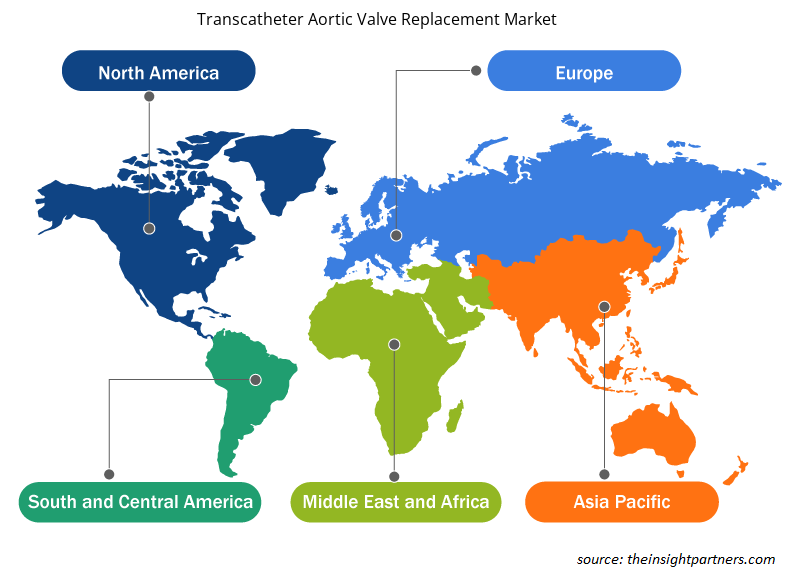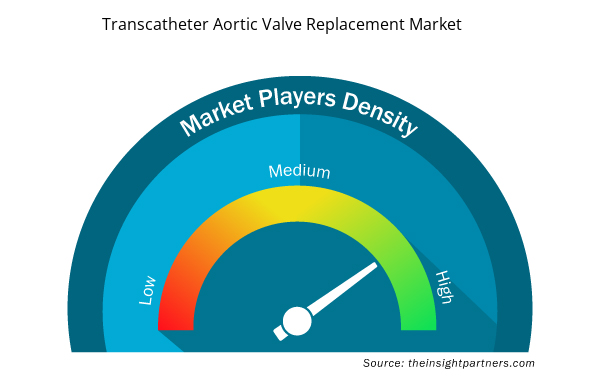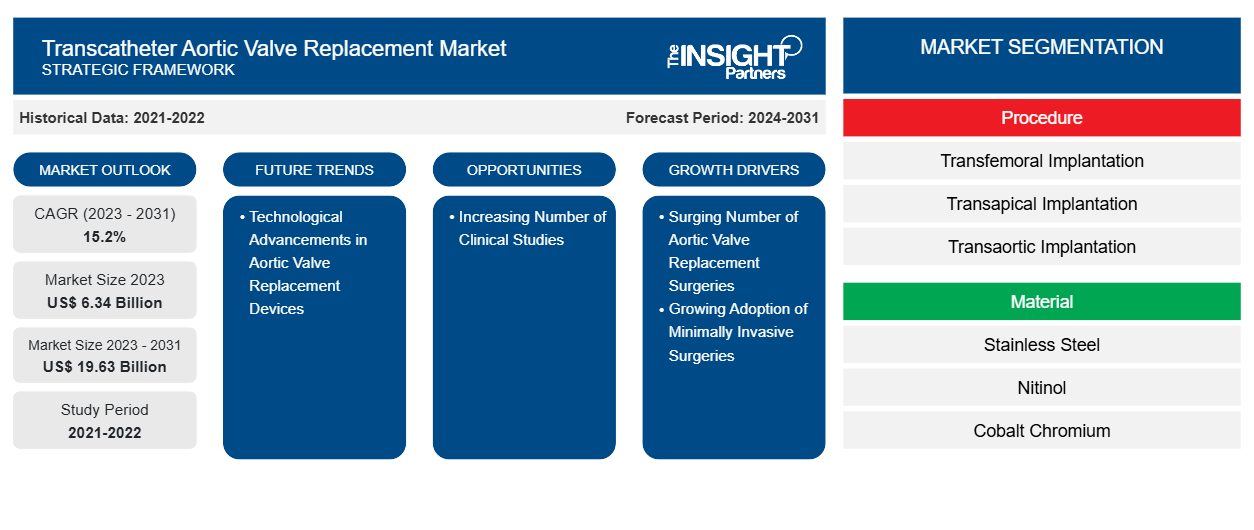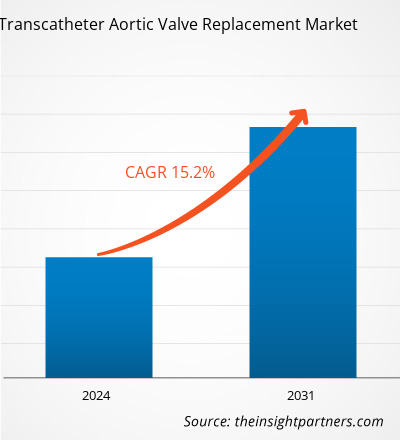Der Markt für den transkatheteralen Aortenklappenersatz soll von 6,34 Milliarden US-Dollar im Jahr 2023 auf 19,63 Milliarden US-Dollar im Jahr 2031 wachsen; für den Zeitraum von 2023 bis 2031 wird eine durchschnittliche jährliche Wachstumsrate (CAGR) von 15,2 % erwartet.
Der transkatheterale Aortenklappenersatz (TAVR) ist ein minimalinvasiver Eingriff, bei dem mithilfe eines Katheters eine neue Klappe in die alte Aortenklappe eingesetzt wird. Im Vergleich zu einer herkömmlichen Klappenersatzoperation am offenen Herzen ist die Genesung nach dem Eingriff schneller und kann eine sinnvolle Option für Patienten sein, die nur begrenzte Möglichkeiten zur Behandlung ihrer Aortenstenose haben.Der Bericht enthält Wachstumsaussichten aufgrund der aktuellen Markttrends für den transkatheteralen Aortenklappenersatz und ihrer vorhersehbaren Auswirkungen während des Prognosezeitraums.
Faktoren, die das Marktwachstum für transkatheteralen Aortenklappenersatz beeinflussen
Laut Angaben des Texas Heart Institute werden in den USA jährlich etwa 106.000 Herzklappenoperationen durchgeführt. Bei fast allen dieser Eingriffe werden die Mitral- oder Aortenklappen repariert oder ersetzt. Dieser Anstieg ist auf die steigende Zahl chronischer Klappenerkrankungen wie Aortenstenose und Linksventrikelhypertrophie zurückzuführen. Darüber hinaus tragen Fortschritte in der Medizintechnik, die Alterung der Bevölkerung und ein verbessertes Bewusstsein für Herzerkrankungen zur Zunahme der Herzklappenersatzoperationen bei. Der Aortenklappenersatz ist ein kritischer Eingriff, der häufig zur Behandlung von Aortenklappenstenose oder -insuffizienz eingesetzt wird. Diese Erkrankungen können zu schweren Komplikationen führen, wenn sie unbehandelt bleiben. Da sich die Medizinwissenschaft weiterentwickelt, werden diese Operationen voraussichtlich noch sicherer und zugänglicher, was zu besseren Patientenergebnissen beiträgt und die Lebensqualität der von Aortenklappenerkrankungen Betroffenen verbessert. Die Gesundheitssysteme passen sich an, um dieser wachsenden Nachfrage nach chirurgischen Eingriffen gerecht zu werden, und betonen die Bedeutung von Präventivmaßnahmen und Früherkennung bei der Behandlung der kardiovaskulären Gesundheit. Ein deutlicher Anstieg der Zahl der Operationen zum Aortenklappenersatz stärkt den Markt für den transkatheteralen Aortenklappenersatz.
Die steigende Zahl von Produktrückrufen aufgrund von Konstruktionsfehlern, Herstellungsfehlern oder unzureichenden Sicherheitsstandards hat bei Gesundheitsdienstleistern und Patienten Bedenken geweckt und das Marktwachstum für Aortenklappenersatzgeräte eingeschränkt. Folglich können Produktrückrufe das Markenimage schädigen und zu einem potenziellen Rückgang der Nachfrage nach Produkten und Dienstleistungen zum Aortenklappenersatz führen. Patienten und medizinisches Fachpersonal werden bei der Betrachtung dieser Geräte möglicherweise vorsichtiger, was zu einer hohen Wahrscheinlichkeit führt, dass sie sich für Alternativen entscheiden oder Verfahren verzögern.
Nachfolgend sind einige Produktrückrufe der wichtigsten Akteure auf dem Markt für Geräte zum Aortenklappenersatz aufgeführt:
- Im April 2023 rief Medtronic Australasia seine transkatheterale Aortenklappe EvolutTM PRO+34 mm aufgrund des ernsthaften Risikos einer Klappeneinfaltung zurück. Aufgrund dieses Problems stellte Medtronic den Vertrieb dieses Produkts über das Special Access Scheme (SAS) ein.
- Im Juni 2023 rief Abiomed, Inc. Impella-Blutpumpen für die linke Seite zurück, die zur kurzfristigen Unterstützung der Pumpkammern des Herzens bei perkutanen Koronarinterventionen (PCI) vorgesehen sind. Laut FDA wurde der Rückruf durch unzureichende Gebrauchsanweisungen für die Pumpe ausgelöst, die den Ärzten nicht genügend Anleitung zur Behandlung von Patienten gaben, die sich einem transkatheteralen Aortenklappenersatz unterzogen hatten.
- Im Januar 2021 leitete Boston Scientific Corporation einen weltweiten, freiwilligen Rückruf aller unbenutzten Lagerbestände des LOTUS Edge Aortenklappensystems aufgrund von Komplexitäten im Zusammenhang mit dem Produktabgabesystem ein. Der freiwillige Rückruf bezieht sich nur auf das Abgabesystem.
Passen Sie diesen Bericht Ihren Anforderungen an
Sie erhalten kostenlose Anpassungen an jedem Bericht, einschließlich Teilen dieses Berichts oder einer Analyse auf Länderebene, eines Excel-Datenpakets sowie tolle Angebote und Rabatte für Start-ups und Universitäten.
- Holen Sie sich die wichtigsten Markttrends aus diesem Bericht.Dieses KOSTENLOSE Beispiel umfasst eine Datenanalyse von Markttrends bis hin zu Schätzungen und Prognosen.
Berichtssegmentierung und Umfang
Die „Globale Marktanalyse für transkatheteralen Aortenklappenersatz bis 2031“ ist eine eingehende Studie der Pharmaindustrie mit besonderem Schwerpunkt auf der Analyse globaler Markttrends. Der Bericht soll einen Überblick über den Markt mit detaillierter Marktsegmentierung basierend auf Verfahren, Material, Mechanismus, Endbenutzer und Geografie bieten. Er liefert wichtige Statistiken zu den führenden Marktteilnehmern und erwähnt wichtige Trends und Chancen, die auf dem Markt vorherrschen.Der geografische Umfang des globalen Marktberichts zum transkatheteralen Aortenklappenersatz umfasst Nordamerika (USA, Kanada und Mexiko), Europa (Deutschland, Frankreich, Italien, Großbritannien, Spanien und das übrige Europa), den asiatisch-pazifischen Raum (China, Japan, Indien, Australien, Südkorea und den übrigen asiatisch-pazifischen Raum), den Nahen Osten und Afrika (Südafrika, Saudi-Arabien, Vereinigte Arabische Emirate und den übrigen Nahen Osten und Afrika) sowie Süd- und Mittelamerika (Brasilien, Argentinien und den übrigen Süd- und Mittelamerika).
Verfahrensbasierte Erkenntnisse
Bezogen aufVerfahren, der Markt ist segmentiert in transfemorale Implantation, transapikale Implantation und transaortische Implantation. Das Segment der transfemoralen Implantation hatte 2023 den größten Marktanteil beim transkatheteralen Aortenklappenersatz und wird voraussichtlich von 2023 bis 2031 die höchste durchschnittliche jährliche Wachstumsrate verzeichnen.
Materialbasierte Erkenntnisse
Basierend auf dem Material ist der Markt in Edelstahl , Nitinol, Kobalt-Chrom und andere segmentiert. Das Kobalt-Chrom-Segment hatte 2023 den größten Marktanteil und wird voraussichtlich von 2023 bis 2031 die höchste durchschnittliche jährliche Wachstumsrate verzeichnen.
Mechanismusbasierte Erkenntnisse
Basierend auf dem Mechanismus ist der Markt in Ballonexpansionsventile und selbstexpandierende Ventile unterteilt. Das Segment der Ballonexpansionsventile hatte 2023 den größten Marktanteil und wird voraussichtlich von 2023 bis 2031 die höchste durchschnittliche jährliche Wachstumsrate verzeichnen.
Endbenutzerbasierte Erkenntnisse
Bezogen aufEndbenutzer,Der Markt ist in Krankenhäuser, ambulante chirurgische Zentren und andere unterteilt.Das Krankenhaussegment hatte 2023 den größten Marktanteil. Dies ist auf die Verfügbarkeit besserer Einrichtungen und qualifizierter Ärzte in Krankenhäusern zurückzuführen. Darüber hinaus wird erwartet, dass das Segment der ambulanten chirurgischen Zentren von 2023 bis 2031 die höchste durchschnittliche jährliche Wachstumsrate verzeichnet.
Regionale Einblicke in den Markt für transkatheteralen Aortenklappenersatz
Die regionalen Trends und Faktoren, die den Markt für transkatheteralen Aortenklappenersatz während des gesamten Prognosezeitraums beeinflussen, wurden von den Analysten von Insight Partners ausführlich erläutert. In diesem Abschnitt werden auch die Marktsegmente und die Geografie für transkatheteralen Aortenklappenersatz in Nordamerika, Europa, im asiatisch-pazifischen Raum, im Nahen Osten und Afrika sowie in Süd- und Mittelamerika erörtert.

- Erhalten Sie regionale Daten zum Markt für transkatheteralen Aortenklappenersatz
Umfang des Marktberichts zum transkatheteralen Aortenklappenersatz
| Berichtsattribut | Details |
|---|---|
| Marktgröße im Jahr 2023 | 6,34 Milliarden US-Dollar |
| Marktgröße bis 2031 | 19,63 Milliarden US-Dollar |
| Globale CAGR (2023 - 2031) | 15,2 % |
| Historische Daten | 2021-2022 |
| Prognosezeitraum | 2024–2031 |
| Abgedeckte Segmente | Nach Verfahren
|
| Abgedeckte Regionen und Länder | Nordamerika
|
| Marktführer und wichtige Unternehmensprofile |
|
Marktteilnehmerdichte für transkatheteralen Aortenklappenersatz: Auswirkungen auf die Geschäftsdynamik verstehen
Der Markt für transkatheteralen Aortenklappenersatz wächst rasant. Dies wird durch die steigende Nachfrage der Endnutzer aufgrund von Faktoren wie sich entwickelnden Verbraucherpräferenzen, technologischen Fortschritten und einem größeren Bewusstsein für die Vorteile des Produkts vorangetrieben. Mit der steigenden Nachfrage erweitern Unternehmen ihr Angebot, entwickeln Innovationen, um die Bedürfnisse der Verbraucher zu erfüllen, und nutzen neue Trends, was das Marktwachstum weiter ankurbelt.
Die Marktteilnehmerdichte bezieht sich auf die Verteilung der Firmen oder Unternehmen, die in einem bestimmten Markt oder einer bestimmten Branche tätig sind. Sie gibt an, wie viele Wettbewerber (Marktteilnehmer) in einem bestimmten Marktraum im Verhältnis zu seiner Größe oder seinem gesamten Marktwert präsent sind.
Die wichtigsten Unternehmen auf dem Markt für transkatheteralen Aortenklappenersatz sind:
- Abbott Laboratories;
- Medtronic Pls.;
- Artivion Inc.;
- Boston Scientific Corp.;
- Edwards Lifesciences Corp.;
- JenaValve-Technologie, Inc.;
Haftungsausschluss : Die oben aufgeführten Unternehmen sind nicht in einer bestimmten Reihenfolge aufgeführt.

- Überblick über die wichtigsten Akteure auf dem Markt für transkatheteralen Aortenklappenersatz
Regionale Analyse
Geografisch ist der Markt hauptsächlich in Nordamerika, Asien-Pazifik, Europa, den Nahen Osten und Afrika sowie Süd- und Mittelamerika segmentiert.Gemessen am Umsatz hatte Nordamerika im Jahr 2023 den größten Marktanteil im Bereich des transkatheteralen Aortenklappenersatzes.Aufgrund der steigenden Zahl an Herzerkrankungen und der zunehmenden Produkteinführungen wichtiger Akteure dominieren die USA den Markt in dieser Region.
Branchenentwicklungen und zukünftige Chancen:
Die Marktprognose für den transkatheteralen Aortenklappenersatz kann den Akteuren in diesem Markt bei der Planung ihrer Wachstumsstrategien helfen. Laut Pressemitteilungen des Unternehmens sind im Folgenden einige strategische Entwicklungen führender Akteure auf dem Weltmarkt aufgeführt:
- Im Dezember 2022 brachte Abbott das Navitor TAVI-System zur Behandlung von Aortenstenose in Indien auf den Markt. Dieses TAVI-System der neuesten Generation bietet erstklassige Einführbarkeit und Zugang durch kleine Gefäße. Das System mit seinen fortschrittlichen Funktionen trägt dazu bei, das Risiko eines Blutaustritts um das Klappenimplantat herum zu verringern oder zu eliminieren und erweitert so letztlich die Behandlungsmöglichkeiten für Patienten mit schwerer Aortenstenose.
- Im September 2022 bringt Medtronic in den USA das TAVR-System der nächsten Generation Evolut FX zur Behandlung symptomatischer schwerer Aortenstenose auf den Markt. Dieses selbstexpandierende System verbesserte die Kommissurenausrichtung bei TAVR-Verfahren im Vergleich zu Evolut-Systemen der früheren Generation deutlich.
Abbott Laboratories; Medtronic Plc.; Artivion Inc; Boston Scientific Corp; Edwards Lifesciences Corp; JenaValve Technology, Inc.; Blue Sail Medical Co Ltd; JC Medical, Inc; Venus Medtech HangZhou Inc; und Anteris Technologies Ltd sind einige der wichtigsten Unternehmen, die imMarktbericht zum transkatheteralen Aortenklappenersatz. Diese führenden Akteure konzentrieren sich auf die Ausweitung und Diversifizierung ihrer Marktpräsenz und ihres Kundenstamms und nutzen Geschäftsmöglichkeiten auf dem Markt.
- Historische Analyse (2 Jahre), Basisjahr, Prognose (7 Jahre) mit CAGR
- PEST- und SWOT-Analyse
- Marktgröße Wert/Volumen – Global, Regional, Land
- Branche und Wettbewerbsumfeld
- Excel-Datensatz



Report Coverage
Revenue forecast, Company Analysis, Industry landscape, Growth factors, and Trends

Segment Covered
This text is related
to segments covered.

Regional Scope
North America, Europe, Asia Pacific, Middle East & Africa, South & Central America

Country Scope
This text is related
to country scope.
Häufig gestellte Fragen
The transcatheter aortic valve replacement market is expected to be valued at US$ 19.63 billion in 2031.
The transcatheter aortic valve replacement market, by material, is segmented into stainless steel, nitinol, cobalt chromium, and others. The cobalt chromium segment held a larger market share in 2023.
The transcatheter aortic valve replacement market was valued at US$ 6.34 billion in 2023.
The transcatheter aortic valve replacement market majorly consists of the players, including Abbott Laboratories; Medtronic Plc.; Artivion Inc; Boston Scientific Corp; Edwards Lifesciences Corp; JenaValve Technology, Inc.; Blue Sail Medical Co Ltd; JC Medical, Inc; Venus Medtech Hang Zhou Inc; and Anteris Technologies Ltd.
Key factors driving the transcatheter aortic valve replacement market growth are the rising number of aortic valve replacement surgeries and the adoption of minimally invasive procedures for aortic stenosis (AS) treatments.
Transcatheter aortic valve replacement (TAVR) is a minimally invasive procedure that involves the insertion of a new valve inside the old aortic valve using a catheter. The procedure is followed by a quicker recovery process compared to traditional open-heart valve replacement surgery, and can be a viable option for patients who have limited choices in treating their aortic stenosis.
Trends and growth analysis reports related to Life Sciences : READ MORE..
The List of Companies - Transcatheter Aortic Valve Replacement Market
- Abbott Laboratories
- Medtronic Plc.
- Artivion Inc
- Boston Scientific Corp
- Edwards Lifesciences Corp
- JenaValve Technology, Inc.
- Blue Sail Medical Co Ltd
- JC Medical, Inc
- Venus Medtech HangZhou Inc
- Anteris Technologies Ltd
The Insight Partners performs research in 4 major stages: Data Collection & Secondary Research, Primary Research, Data Analysis and Data Triangulation & Final Review.
- Data Collection and Secondary Research:
As a market research and consulting firm operating from a decade, we have published and advised several client across the globe. First step for any study will start with an assessment of currently available data and insights from existing reports. Further, historical and current market information is collected from Investor Presentations, Annual Reports, SEC Filings, etc., and other information related to company’s performance and market positioning are gathered from Paid Databases (Factiva, Hoovers, and Reuters) and various other publications available in public domain.
Several associations trade associates, technical forums, institutes, societies and organization are accessed to gain technical as well as market related insights through their publications such as research papers, blogs and press releases related to the studies are referred to get cues about the market. Further, white papers, journals, magazines, and other news articles published in last 3 years are scrutinized and analyzed to understand the current market trends.
- Primary Research:
The primarily interview analysis comprise of data obtained from industry participants interview and answers to survey questions gathered by in-house primary team.
For primary research, interviews are conducted with industry experts/CEOs/Marketing Managers/VPs/Subject Matter Experts from both demand and supply side to get a 360-degree view of the market. The primary team conducts several interviews based on the complexity of the markets to understand the various market trends and dynamics which makes research more credible and precise.
A typical research interview fulfils the following functions:
- Provides first-hand information on the market size, market trends, growth trends, competitive landscape, and outlook
- Validates and strengthens in-house secondary research findings
- Develops the analysis team’s expertise and market understanding
Primary research involves email interactions and telephone interviews for each market, category, segment, and sub-segment across geographies. The participants who typically take part in such a process include, but are not limited to:
- Industry participants: VPs, business development managers, market intelligence managers and national sales managers
- Outside experts: Valuation experts, research analysts and key opinion leaders specializing in the electronics and semiconductor industry.
Below is the breakup of our primary respondents by company, designation, and region:

Once we receive the confirmation from primary research sources or primary respondents, we finalize the base year market estimation and forecast the data as per the macroeconomic and microeconomic factors assessed during data collection.
- Data Analysis:
Once data is validated through both secondary as well as primary respondents, we finalize the market estimations by hypothesis formulation and factor analysis at regional and country level.
- Macro-Economic Factor Analysis:
We analyse macroeconomic indicators such the gross domestic product (GDP), increase in the demand for goods and services across industries, technological advancement, regional economic growth, governmental policies, the influence of COVID-19, PEST analysis, and other aspects. This analysis aids in setting benchmarks for various nations/regions and approximating market splits. Additionally, the general trend of the aforementioned components aid in determining the market's development possibilities.
- Country Level Data:
Various factors that are especially aligned to the country are taken into account to determine the market size for a certain area and country, including the presence of vendors, such as headquarters and offices, the country's GDP, demand patterns, and industry growth. To comprehend the market dynamics for the nation, a number of growth variables, inhibitors, application areas, and current market trends are researched. The aforementioned elements aid in determining the country's overall market's growth potential.
- Company Profile:
The “Table of Contents” is formulated by listing and analyzing more than 25 - 30 companies operating in the market ecosystem across geographies. However, we profile only 10 companies as a standard practice in our syndicate reports. These 10 companies comprise leading, emerging, and regional players. Nonetheless, our analysis is not restricted to the 10 listed companies, we also analyze other companies present in the market to develop a holistic view and understand the prevailing trends. The “Company Profiles” section in the report covers key facts, business description, products & services, financial information, SWOT analysis, and key developments. The financial information presented is extracted from the annual reports and official documents of the publicly listed companies. Upon collecting the information for the sections of respective companies, we verify them via various primary sources and then compile the data in respective company profiles. The company level information helps us in deriving the base number as well as in forecasting the market size.
- Developing Base Number:
Aggregation of sales statistics (2020-2022) and macro-economic factor, and other secondary and primary research insights are utilized to arrive at base number and related market shares for 2022. The data gaps are identified in this step and relevant market data is analyzed, collected from paid primary interviews or databases. On finalizing the base year market size, forecasts are developed on the basis of macro-economic, industry and market growth factors and company level analysis.
- Data Triangulation and Final Review:
The market findings and base year market size calculations are validated from supply as well as demand side. Demand side validations are based on macro-economic factor analysis and benchmarks for respective regions and countries. In case of supply side validations, revenues of major companies are estimated (in case not available) based on industry benchmark, approximate number of employees, product portfolio, and primary interviews revenues are gathered. Further revenue from target product/service segment is assessed to avoid overshooting of market statistics. In case of heavy deviations between supply and demand side values, all thes steps are repeated to achieve synchronization.
We follow an iterative model, wherein we share our research findings with Subject Matter Experts (SME’s) and Key Opinion Leaders (KOLs) until consensus view of the market is not formulated – this model negates any drastic deviation in the opinions of experts. Only validated and universally acceptable research findings are quoted in our reports.
We have important check points that we use to validate our research findings – which we call – data triangulation, where we validate the information, we generate from secondary sources with primary interviews and then we re-validate with our internal data bases and Subject matter experts. This comprehensive model enables us to deliver high quality, reliable data in shortest possible time.


 Holen Sie sich ein kostenloses Muster für diesen Bericht
Holen Sie sich ein kostenloses Muster für diesen Bericht